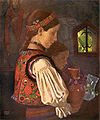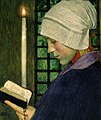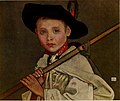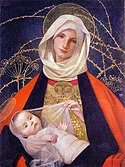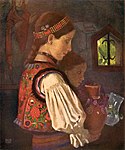Marianne Stokes
Marianne Stokes auch Mrs. Adrian Stokes, geborene Preindlsberger (* 19. Januar 1855 in Graz; † 13. August 1927 in London) war eine österreichisch-britische Malerin.
Leben

Marianne Preindlsberger studierte zunächst Kunst an der Münchner Akademie bei Wilhelm von Lindenschmit. Unter dem Einfluss der Münchner Schule entstanden Frühwerke wie das Gemälde Träumendes Mädchen aus dem Jahr 1875. Später wechselte sie mit einem Stipendium an die École des Beaux-Arts in Paris und nahm Unterricht bei Pascal Adolphe Dagnan-Bouveret. Die Malerin arbeitete in Paris und der Umgebung und fand im Naturalismus der Gemälde von Jules Bastien-Lepage und Jean-François Millet neue Vorbilder. 1883 lernte sie bei einem Aufenthalt in Pont-Aven in der Bretagne den englischen Maler Adrian Scott Stokes (1854–1935) kennen. Ihn heiratete sie 1884 und zog mit ihm nach England. Marianne Stokes dort entstandenes Gemälde Reflection stellte sie im selben Jahr im Pariser Salon aus. Nach einer erneuten Präsentation des Gemäldes 1885 in der Royal Academy of Arts kaufte es die Walker Art Gallery in Liverpool an. 1886 folgten Marianne and Adrian Stokes den Ruf des irischen Malers Stanhope Forbes, dem Gründer der Künstlerkolonie Newlyn School, nach St Ives in Cornwall, wo sie von Helene Schjerfbeck längeren Besuch erhielten. Hier entstanden überwiegend ländliche Genreszenen. Im gleichen Jahr besuchte das Paar auch die Künstlerkolonie in Skagen an der Nordspitze Dänemarks. (Michael Anchers Gemälde „Kindstaufe“ und eine Reihe von Fotos belegen diese Beziehung zu den Skagenmalern). Später lebten Adrian und Marianne Stokes an verschiedenen Orten in England. Neben regelmäßigen Ausstellungen in der Royal Academy, nahm sie 1893 auch mit einigen Gemälden an der World Columbian Exposition in Chicago teil, wo sie mit einer Medaille ausgezeichnet wurde.
In den 1890er Jahren wandte sich Marianne Strokes in ihrem Werk häufig mittelalterlichen, religiösen und mythischen Motiven zu. Der Einfluss und die Tradition der britischen Präraffaeliten und vom Jugendstil tritt hierbei deutlich hervor. Um die Jahrhundertwende entfalteten Marianne and Adrian Stokes eine weite Reisetätigkeit. Einer gemeinsamen Reise des Ehepaars Stokes nach Ždiar in den Karpaten folgte das 1909 in London erschienene Buch Hungary, dessen von Marianne Stokes stammende Porträtstudien slowakischer Bergbäuerinnen auch volkskundliche Bedeutung haben. 1923 wurde Marianne Stokes Mitglied der Royal Society of Painters in Water Colours, der späteren Royal Watercolour Society.
Werke der Künstlerin befinden sich unter anderem in der Londoner Tate Gallery, im Kölner Wallraf-Richartz-Museum & Fondation Corboud und in den öffentlichen Sammlungen von Pittsburgh, Manchester und Wolverhampton.
Ausgewählte Werke
- On the Way to the Fields
- Träumendes Mädchen
- Madonna and Child
- Aucassin and Nicolette
- Angels Entertaining the Holy Child
- Romanian Children bringing Water to be Blessed in the Greek Church, Desze
- Maria Lichtmess
- Hungarian portrait
- Hungarian boy
- A Rumanian Bridesmaid
- An Angel
Literatur
- Adrian Stokes: Hungary: painted by Adrian & Marianne Stokes London 1909
- Atholl Hill: Aspects of Victorian art London 1971
- Ausstellungskatalog London: Peintres de l'ame London 1984
- John Christian (Hrsg.): The last romantics: the romantic tradition in British art, Burne-Jones to Stanley Spencer London 1989 ISBN 0-85331-552-3
- Magdalen Evans: Hungarian journeys: landscapes and portraits, 1905–1910, Marianne & Adrian Stokes London 1996 ISBN 095292210X
- Magdalen Evans: Utmost Fidelity. The painting lives of Marianne and Adrian Stokes, Wolverhampton Art Gallery (Ausstellungskatalog 30. Jänner bis 3. April 2009), Sansom & Co, Bristol 2009
Weblinks
- Marianne Stokes bei Victorian Art in Britain (englisch)
- Wiener Zeitung:Robert Schediwy - Marianne Stokes, eine vergessene steirische Malerin ( vom 5. Februar 2006 im Internet Archive)
- Artikel in Kleine Zeitung, Graz 2009. Kleine Zeitung, 23. Februar 2009, archiviert vom am 12. Oktober 2014.
- Das Warten im Wald. Bild der 4. Woche - 24. bis 31. Januar 2000. Zu "Schneewitchen", Wallraf-Richartz-Museum & Fondation Corboud
- Prinzessin im Walde. Bild der 33. Woche - 13. bis 20. August 2001. Zu "Melisande", Wallraf-Richartz-Museum & Fondation Corboud
| Personendaten | |
|---|---|
| NAME | Stokes, Marianne |
| ALTERNATIVNAMEN | Preindlsberger, Marianne |
| KURZBESCHREIBUNG | österreichisch-britische Malerin |
| GEBURTSDATUM | 19. Januar 1855 |
| GEBURTSORT | Graz |
| STERBEDATUM | 13. August 1927 |
| STERBEORT | London |
Auf dieser Seite verwendete Medien
Autor/Urheber: Internet Archive Book Images, Lizenz: No restrictions
Identifier: hungary00stok
Title: Hungary
Year: 1909 (1900s)
Authors: Stokes, Adrian, 1854-1935 Stokes, Marianne
Subjects:
Publisher: London : A. and C. Black
Contributing Library: Robarts - University of Toronto
Digitizing Sponsor: University of Toronto
View Book Page: Book Viewer
About This Book: Catalog Entry
View All Images: All Images From Book
Click here to view book online to see this illustration in context in a browseable online version of this book.
Text Appearing Before Image:
Then a gentleman spoke tome, advising me to keep wideawake, as at anymoment the soldiers might have to clear thesquare. The shops were, of course, all closed, but thehotels were crowded, and at the door of each playeda band, while crowds of peasants crushed in andout, or strained for bundles of cigars, held aloftby half-suffocated agents. A peasant, white with fury and wet with perspi-ration, struggled in the clutches of two canvassers. What has he done V I again asked a Jew. * Heis drunk and wants to go over to the other party.He has been paid for his vote, was the reply. Towards noon the heat became intense. Noiseand dancing continued unabated, and the smell ofdrink became sickening. I joined the ladies at aplace appointed, when Frau Deutsch — whosescheme, it appeared afterwards, had been to obtaina free meal—led us to the best hotel. From a balcony, overlooking a courtyard full ofpeasants devouring a generous dinner served onmany deal tables, we observed the proceedings. MISKO
Text Appearing After Image:
VAZSECZ AND A PARLIAMENTARY ELECTION 65 Men only, as voters, were seated, but they gavethe food with which they were served to theirwives standing by, who secreted it, and then theycalled for more. This was repeated over and overagain, and only excited our amusement; but whenwe saw some women coolly adding knives, forks,and even plates, to their hidden store, I felt obligedto tell a head-waiter what was going on. * Oh,said he, * it does not matter. We are always paida liberal allowance for theft. The Notarys wife had left us early in the dayand I found it hard to convince our remainingcompanion that, even on election-day, we objectedto obtain food under false pretences. To her—quite honest generally—all seemed fair at such atime, and she would have obtained orders for usto dine as helpers in the great fight. Having eaten, we said good-bye to our landlady,and hoped to be able to explore the town, butfound that every street was barred by soldiers,with orders to let no one by without
Note About Images
Autor/Urheber: Marianne Stokes , Lizenz: No restrictions
Identifier: hungary00stok
Title: Hungary
Year: 1909 (1900s)
Authors: Stokes, Adrian, 1854-1935 Stokes, Marianne
Subjects:
Publisher: London : A. and C. Black
Contributing Library: Robarts - University of Toronto
Digitizing Sponsor: University of Toronto
View Book Page: Book Viewer
About This Book: Catalog Entry
View All Images: All Images From Book
Click here to view book online to see this illustration in context in a browseable online version of this book.
Text Appearing Before Image:
in his light red summer coat. Nearer, ever nearer,came the hounds. The buck stepped down the edgeof the wood till opposite my place of concealment,then suddenly broke away, and, leaping over thestones and undergrowth between us, came on to hisfate. The guest of the day, a rubicund and jovialJudge, was on my left. Presently I heard himshoot twice, and then a second buck, going likethe wind, flashed between me and the wood. Myfirst barrel had no effect, but the second, aimedwell in front, bowled him head over heels, andhe lay dead. The Judge rushed up with out-stretched hand to clasp mine, and thank me forhaving stopped his quarry, and ask if it was stillgoing when I fired! As a matter of fact, it hadseen him when about to shoot, doubled back, andonly offered a long shot from behind, which couldhave had no effect but to accelerate its pace.However, some shot were found near its hind-quarters, and at the end of the day he carriedit off in triumph to Budapest. SLOVAK GIRL IN SUNDAY ATTIRE
Text Appearing After Image:
VAZSECZ AND LUCSIVNA-FURDO 73 The drive was over. Beaters and hounds drewnear, the guns assembled round a fire, and heartycompHments were paid to me. Then a hamperwas opened, wine and mineral waters were handedround, cigars lit, and one or other of the company-started snatches of old Hungarian hunting songs,the rest forming a chorus. After each drive, and whenever we stopped fora short rest or consultation, a fire was at oncemade by the beaters. They all smoked pipeswith small clay bowls closed with metal lids andstuffed with strong tobacco, which they hadpreviously moistened with saliva and rolled uptight in the palms of their hands. The heads ofthe pipes were then thrust among the glowingembers of the fire to roast, and afterwards thetobacco was lit in the usual way. This methodwas said to make it burn more slowly and tastestronger than any other known. Several outlying parts of the forest were driven,and a few hares fell before we arrived at the shedwhere luncheon was prepared, but
Note About Images





